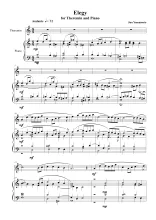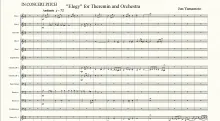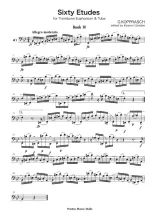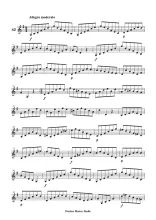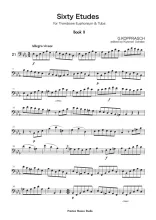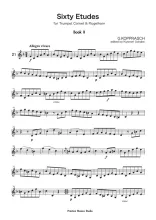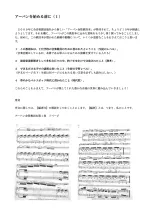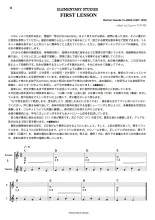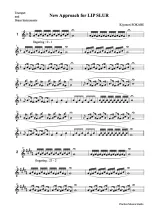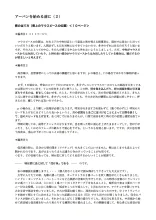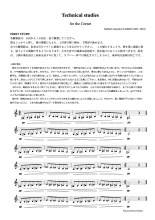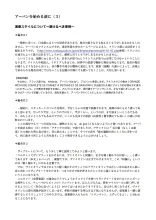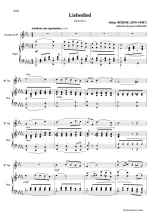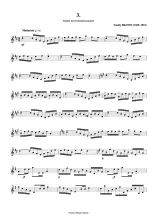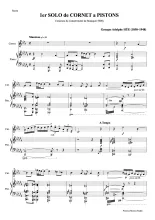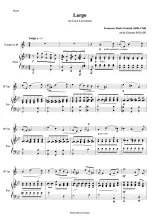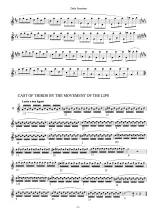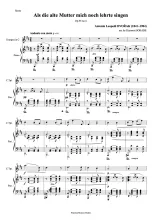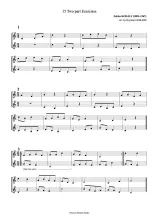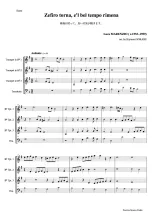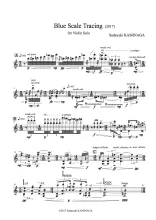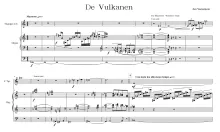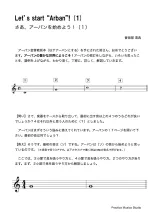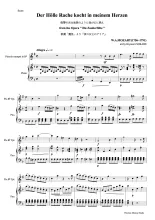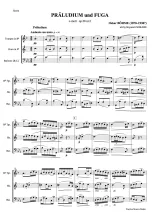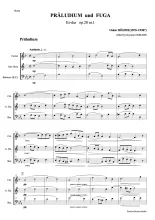New Releases
Our Staff Picks
News
De Vulkanen (The Volcanos) (Trp. Pipeorgan)
YAMAMOTO, Jun山本準
This piece (about 8 minutes long) was composed with the intention to bring out the rich sound of the pipe organ and trumpet as much as possible. The music starts with Eb by pedal of the organ. Over the arpeggios of the organ, the theme by the trumpet and pedal tone of organ clime up to reach the major triad on F#. In the second part, the right hand of the organ and the trumpet exchange melodies of mainly 16th notes on a constant running of the left hand of the organ. The central sound in this part changes from Bb, Eb, Gb B and D. The melody line also develops in the scale according to the center tone. The music reaches the solo of the trumpet and the organ makes comping to it. The third part begins with the organ's short cadenza. On the persistent ostinato at the lower part of the organ, the trumpet and the organ's right hand exchange lines of 16th notes, increasing tension from the trumpet and the organ's triplet unison to the climax with the trumpet's harmonic glissandos. After the introduction part is reflected after a pause, the gradually piled up chords designated "Placare" change their color little by little, and finally the music concludes quietly on the chord consisting of 8 tones including the Major and Minor triad on the base note of E natural.
This piece has been premiered by Duo Babaar (Trumpet Sogabe Kiyonori, Organ Tsukatani Minako) at Nishikatamachi Church in Tokyo on June 29, 2019.
本作品(演奏時間 約8分)はパイプオルガンとトランペットの豊かな響きを最大限引き出したいという意図の下に作曲された。曲は変ホ音のペダルから始まる序奏に続き、オルガンのアルペジオにのってトランペットとオルガンの低音部のオクターブによる上行する旋律を経て、オルガンの明確な嬰へ音上の長三和音に到達する。第2部分は、オルガンの左手によるコンスタントなスケールにのってオルガンの右手とトランペットが16分音符を中心とした旋律を交換しあう。この部分の中心音は、変ロ音から、変ホ音、変ト音、ロ音を経てニ音に変化していき、それに伴い旋律線もそれぞれの中心音に従った音階において展開して高潮して、トランペットのソロに到達し、これにオルガンが「合いの手」を入れる形となり、最終的にはオルガンはト音上の長三和音、トランペットは嬰ト音に達して休止する。第3部分はオルガンの短いカデンツァをへてオルガン低音部の執拗なオスティナートが始まりトランペットとオルガンの右手によりさらに16分音符を中心としたラインがやり取りされて緊張を増し、トランペットとオルガンの3連符によるユニゾンから、トランペットのハーモニック・グリッサンドを伴うクライマックスに達する。休止ののち序奏部分が再現したあと、Placare(なだめるように)が指定された徐々に積み重なる和音が少しずつ構成を変えながら、最後はホ音上の長三度と短三度を同時に含む8音からなる和音上で静かに曲を閉じる。
本作品は2019年6月29日東京・日本基督教西片町教会において、デュオ・ババール(トランペット 曾我部清典、オルガン 塚谷水無子)により初演された。
Vines for flute, clarinet and piano
IMAHORI, Takuya今堀拓也
Vines (2011) for flute, clarinet and piano op. 19 (7 mn)
(piano plays only the normal way, not with internal playing)
premiered: Sep. 15. 2011 Moscow Contemporary Music Ensemble, at The 3rd International Contemporary Music Festival in Pharos Arts Foundation, Nicosia, Cyprus (commissioned by Pharos Arts Foundation)
http://www.reverbnation.com/takuyaimahori/song/10344577-vines-for-flute-clarinet-and-piano
Vines (2011) for flute, clarinet and piano op. 19 (7 mn)
蔓 - フルート、クラリネット、ピアノのための
(ピアノ・ソロは通常奏法のみ、内部奏法なし)
(ファロス財団による委嘱)
初演 : モスクワ現代音楽アンサンブル
(催事) 第3回ファロス財団現代音楽祭2011
(日時場所) 2011年9月15日 シューファクトリー, ニコシア, キプロス
Vines for flute, clarinet and piano
IMAHORI, Takuya今堀拓也
Vines (2011) for flute, clarinet and piano op. 19 (7 mn)
(piano plays only the normal way, not with internal playing)
premiered: Sep. 15. 2011 Moscow Contemporary Music Ensemble, at The 3rd International Contemporary Music Festival in Pharos Arts Foundation, Nicosia, Cyprus (commissioned by Pharos Arts Foundation)
http://www.reverbnation.com/takuyaimahori/song/10344577-vines-for-flute-clarinet-and-piano
Vines (2011) for flute, clarinet and piano op. 19 (7 mn)
蔓 - フルート、クラリネット、ピアノのための
(ピアノ・ソロは通常奏法のみ、内部奏法なし)
(ファロス財団による委嘱)
初演 : モスクワ現代音楽アンサンブル
(催事) 第3回ファロス財団現代音楽祭2011
(日時場所) 2011年9月15日 シューファクトリー, ニコシア, キプロス
Let's start "Arban" 1
SOKABE, Kiyonori曽我部清典
Explanation : no.1 of Arban's Method.
『アーバンを始める前に』に引き続き、アーバン金管教則本について、わかりやすく詳しく解説していきます。その第1回めは、全音版アーバン金管教則本の17ページ、最初の練習曲の第1番のみ!です。
Liebeslied
BÖHME, Oskar (arr. SOKABE, Kiyonori)オスカー・ベーメ(arr. 曽我部清典)
Liebeslied by Oscar Boehme.Op 22-2
オスカル・ベーメのトランペットとピアノのための作品(作品番号22の2)です。残念ながら、他の作品は見つかっていません。ロマンティックな中に少し技巧を取り込んだ作品になっています。リサイタル用の小品として最適。
Liebeslied
BÖHME, Oskar (arr. SOKABE, Kiyonori)オスカー・ベーメ(arr. 曽我部清典)
Liebeslied by Oscar Boehme.Op 22-2
オスカル・ベーメのトランペットとピアノのための作品(作品番号22の2)です。残念ながら、他の作品は見つかっていません。ロマンティックな中に少し技巧を取り込んだ作品になっています。リサイタル用の小品として最適。
Aria of the Queen of the Night from Mozart's opera "The Magic Flute". second act
MOZART, Wolfgang Amadeus (arr. SOKABE, Kiyonori)ウォルフガング・アマデウス・モーツァルト(arr. 曽我部清典)
モーツアルトの歌劇「魔笛」第二幕より、夜の女王のアリア「復讐の炎は地獄のように我が心に燃え」です。
Aria of the Queen of the Night from Mozart's opera "The Magic Flute". second act
MOZART, Wolfgang Amadeus (arr. SOKABE, Kiyonori)ウォルフガング・アマデウス・モーツァルト(arr. 曽我部清典)
モーツアルトの歌劇「魔笛」第二幕より、夜の女王のアリア「復讐の炎は地獄のように我が心に燃え」です。
Suite for Brass Quintet by Kosaku YAMADA
KOSAKU,Yamada (arr. YAMAZAKI, Shigeru)山田耕筰(arr. 山崎茂(しげる))
山田耕筰の歌曲の中でも有名な4曲を金管五重奏曲に編曲しました。この道、からたちの花、待ちぼうけ、赤とんぼの4曲です。最近あまり歌われなくなったように思うので、もっと聴きたいという思いで、作りました。(山崎しげる)
Monograph for Saxophone
YAMAMOTO, Jun山本準
In this work, the composer avoided the aspect of the saxophone as an expressive "singing instrument" and rather based on the steady flow of 16th notes resembling jazz-style ad-lib lines, taking advantage of mechanical mobility of the instrument. The tune consists of three parts and a coda. The first part has a clear tonality (G major as noted). In the second part, the sound system is expanded while maintaining the same flow, and after the first part reappears, it reaches the coda. The tune is written originally for tenor saxophone but can be performed by any of saxophone family, e.g. alto saxophone. This composition has not been premiered yet.
本作品では、サクソフォンの、表情豊かな「歌う楽器」としての面をあえて避けて、むしろ機械的な運動性を活かして、ジャズのアドリブ・ラインに似た定常的な音の流れを基礎においた。曲は3部分およびコーダからなる。第一部ははっきりした調性(記音でのト長調)を持つ。第二部分では同じ流れを保ちつつ音組織を拡げていき、第一部が再現した後コーダに至る。本作品はテナーサクソフォン用だが、他のサクソフォン(たとえばアルト)でも演奏可能である。本作品は公開演奏にて初演されていない。
PRÄLUDIUM und FUGA Nr.2 c-moll
BÖHME, Oskar (arr. SOKABE, Kiyonori)オスカー・ベーメ(arr. 曽我部清典)
オスカー・ベーメの金管三重奏曲プレリュードとフーガ第二番です。オリジナルは、トランペット・アルトホルン・バリトンの三重奏。コルネットやフレンチホルン・ユーフォニアム・トロンボーンでも演奏できます。一番よりさらに内容・技術的にも深い仕上がりになっています。
PRÄLUDIUM und FUGA Nr.1 Es Dur
BÖHME, Oskar (arr. SOKABE, Kiyonori)オスカー・ベーメ(arr. 曽我部清典)
ドレスデン近郊出身のトランペット奏者で作曲家のオスカー・ベーメの金管三重奏曲「プレリュードとフーガ第一番」をリリースしました。オリジナルは、トランペット・アルトホルン・バリトンのトリオですが、コルネット・フレンチホルン・ユーフォニアム(トロンボーン)のパート譜も付けました。
